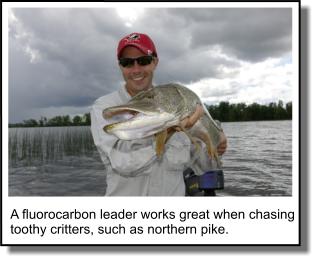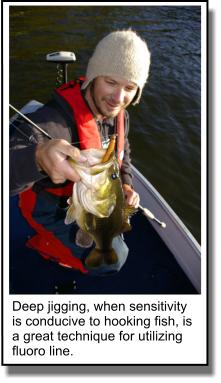The Fundamentals of Fluoro
By Justin Hoffman
 As
the old adage goes, the weakest link between you and a
fish falls squarely on the shoulders of your line. With
a market saturated with choices, including monofilament,
copolymer, and braid, shedding some light on the latest
to join the fraternity – fluorocarbon – will help you
become a more informed, and successful angler.
As
the old adage goes, the weakest link between you and a
fish falls squarely on the shoulders of your line. With
a market saturated with choices, including monofilament,
copolymer, and braid, shedding some light on the latest
to join the fraternity – fluorocarbon – will help you
become a more informed, and successful angler.
The Lowdown
Although not a newcomer to the fishing scene, the buzz
about fluorocarbon line has exploded over the last
couple of years. In terms of manufacturing, fluorocarbon
is a polymer consisting of fluorine that has been
chemically bonded with carbon. This chemical makeup has
almost the same light refraction rate that water holds,
or in laymen terms, it appears virtually invisible when
in the drink.
Fluorocarbon line has unique properties, in comparison
to monofilament, making it resistant to degradation from
such outside sources as sunlight, gasoline, or DEET (a
common component of insect repellant.) As most anglers
know, mono will break down when exposed to such
substances – not the case with fluoro.
If those benefits weren’t enough, fluoro will not absorb
water (another factor in line failure and degradation in
monofilament), is denser than H20 so it sinks, has
greater abrasion qualities, and is highly sensitive with
a decrease in stretch.
Sound too good to be true? All are factual statements,
although independent testers are beginning to question
the claim of fluoro’s decreased stretch properties – the
jury is still out on that one. For now, I’ll take the
manufacturer’s word.
To achieve all of these characteristics, the line you
purchase must be 100% fluorocarbon. Not all are on the
market. Keep a close eye when checking out the tackle
shelves.
All in all, fluorocarbon brings some excellent
advancements to the forefront of line development. Like
anything, though, there are advantages and
disadvantages. Here is the nitty-gritty on those.
Best Uses for Fluorocarbon Line
 The
two most intriguing properties fluoro holds are near
invisibility and a significant resistance to abrasion.
The advantages of invisible line are great – clear water
applications, finicky fish, and finesse presentations.
Catch rates can increase significantly when faced with
these tricky situations, and switching to a line such as
fluorocarbon can see a dramatic upturn – especially
where stealth is concerned.
The
two most intriguing properties fluoro holds are near
invisibility and a significant resistance to abrasion.
The advantages of invisible line are great – clear water
applications, finicky fish, and finesse presentations.
Catch rates can increase significantly when faced with
these tricky situations, and switching to a line such as
fluorocarbon can see a dramatic upturn – especially
where stealth is concerned.
With the advent of zebra mussels, and with more anglers
concentrating on abrasive structure areas (rocks, wood,
docks, snags), using a tough line that can hold up to
these “string eaters” is paramount. Fluoro can bring the
added benefit of toughness and resistance when facing
these conditions.
Increased sensitivity – a factor that makes many anglers
fall in love with braid – is also worth a look in fluoro.
Presentations such as tossing crankbaits, jigging
(especially deep-water and drop-shotting), and working
soft stickbaits can be done more effectively with fluoro.
But is it more sensitive than braid? Not sure. But it
certainly is harder to see under the water, making it a
plus in my books.
Fluorocarbons’ sinking properties also make it
beneficial for those trying to gain extra depth when
fishing certain lures, be it crankbaits or wacky worms,
as well as ensuring that they sink at a faster rate of
speed.
If the stretch claims are true, sinking the hooks into
fish more quickly during certain situations (deep water
jigging comes to mind, as stretch can impede hook
penetration), puts fluorocarbon out on top again.
The Downside to Fluoro
 The
following situations are not necessarily disadvantages,
but more so occasions where fluoro may not be the best
choice.
The
following situations are not necessarily disadvantages,
but more so occasions where fluoro may not be the best
choice.
If working slow moving topwater baits – think Pop R’s –
fluoro’s ability to sink may impede both the action of
your lure, as well as your efficiency in picking up line
for wrist and arm movements. Not necessarily your best
bet.
Although many improvements have been made, fluorocarbon
line does exhibit a greater stiffness and more of a
memory than traditional lines. This can cause problems
when using spinning gear (due to their small spools and
the manner the line comes off), as well as on baitcast
gear if braking systems are not properly adjusted. Takes
a bit of getting used to.
Knot tying is extremely important when using
fluorocarbon line, and if not done properly or with the
appropriate knots, line breakage can occur – and more
frequently than with monofilament. Spending a little
extra time getting that knot perfect can make all the
difference. Definitely not as forgiving as mono, at
least in knot strength.
Of course, expense has to be mentioned when dealing with
any fishing product. Expect to pay significantly more
for fluoro line. Price variances are across the board,
with some economical and other high priced product
available to the consumer. My advice is to read up on
specific reviews, heed positive reports, and ultimately
make an informed decision before buying. Utilizing a
backing on your reels to cut down on cost is definitely
recommended.
Leader Material
Many folk use fluorocarbon line as a leader material, as
certain situations don’t warrant a full spool of fluoro.
Panfishing with light line is one that comes to mind. As
finicky as these fish are, a three-foot “invisible”
leader can definitely work wonders, and is all that is
needed.
Carolina rigs are another good choice for fluoro
leaders, as are drop shots, walleye jigging, and when
trolling or casting for toothy critters. Again, if it is
only your offering that will benefit from the use of
fluoro, then tying on a leader is the way to go.
Knots are a hotly debated subject with fluoro line – tie
one wrong or improperly, and line failure at the knot
can certainly occur. Ask five anglers their preference
and chances are you’ll get many different answers.
Suggested knots to try are Uni to Uni, Blood, and
Surgeons, although there are a host of others. Again,
experiment and see which works best for you.
As for line to lure knots, Palomar and the Double Clinch
seem to get the most play. Whichever you choose,
lubricating the knot is paramount to decreasing the risk
of failure, as well as ensuring that line doesn’t fall
on top of other layers. Similar to doing your homework
on the best line, investigate the best knots before
heading out for the day.
As you can see from this overview, flurocarbon line can
bring some specific perks to the realm of fishing.
Although not advantageous to all situations you may
encounter, I’d recommend introducing it to your arsenal
this season – at the least, in order to see what all the
fuss is about.
Line will always remain the most crucial link between
you and that trophy fish, so choose wisely.


 As
the old adage goes, the weakest link between you and a
fish falls squarely on the shoulders of your line. With
a market saturated with choices, including monofilament,
copolymer, and braid, shedding some light on the latest
to join the fraternity – fluorocarbon – will help you
become a more informed, and successful angler.
As
the old adage goes, the weakest link between you and a
fish falls squarely on the shoulders of your line. With
a market saturated with choices, including monofilament,
copolymer, and braid, shedding some light on the latest
to join the fraternity – fluorocarbon – will help you
become a more informed, and successful angler. The
two most intriguing properties fluoro holds are near
invisibility and a significant resistance to abrasion.
The advantages of invisible line are great – clear water
applications, finicky fish, and finesse presentations.
Catch rates can increase significantly when faced with
these tricky situations, and switching to a line such as
fluorocarbon can see a dramatic upturn – especially
where stealth is concerned.
The
two most intriguing properties fluoro holds are near
invisibility and a significant resistance to abrasion.
The advantages of invisible line are great – clear water
applications, finicky fish, and finesse presentations.
Catch rates can increase significantly when faced with
these tricky situations, and switching to a line such as
fluorocarbon can see a dramatic upturn – especially
where stealth is concerned. The
following situations are not necessarily disadvantages,
but more so occasions where fluoro may not be the best
choice.
The
following situations are not necessarily disadvantages,
but more so occasions where fluoro may not be the best
choice.